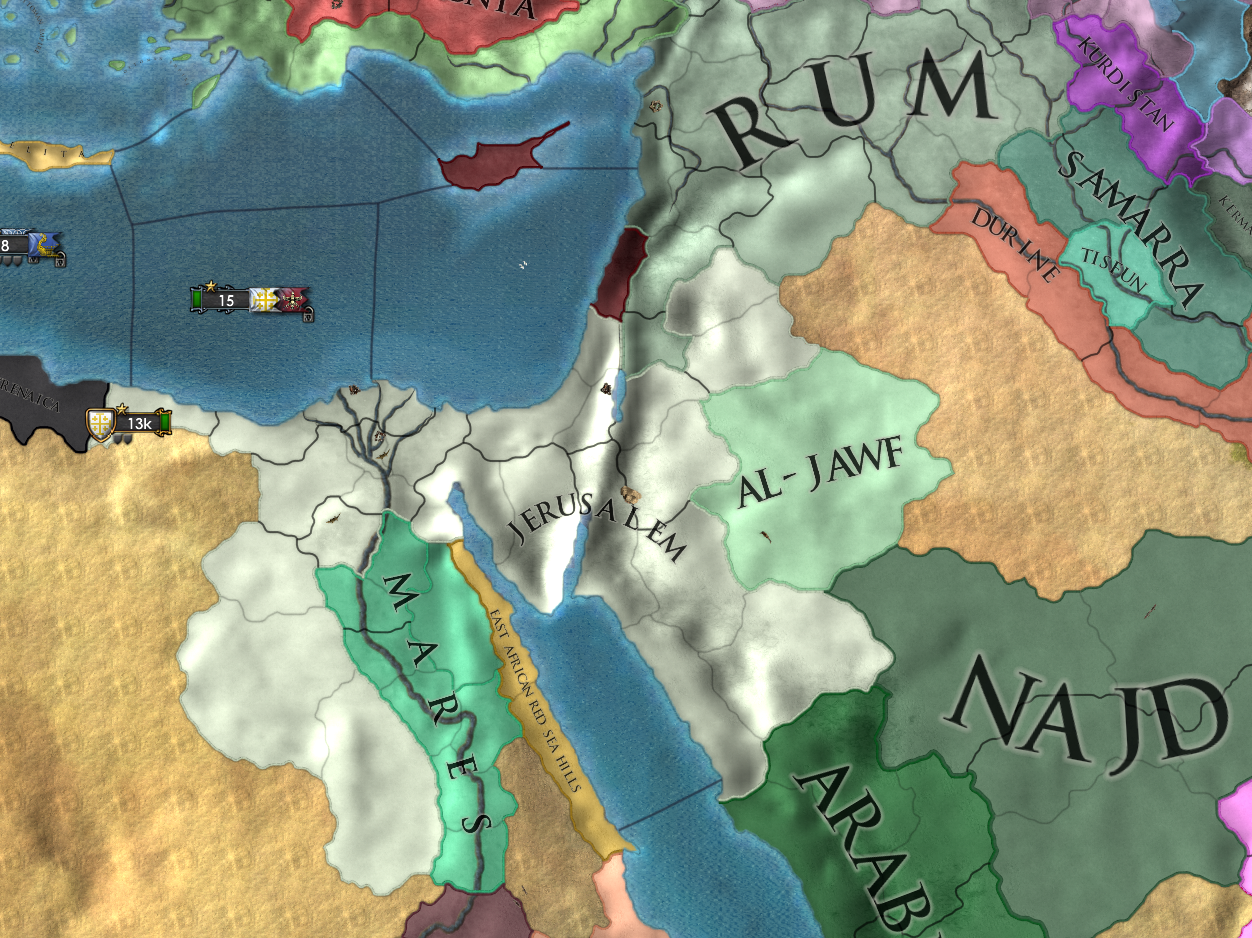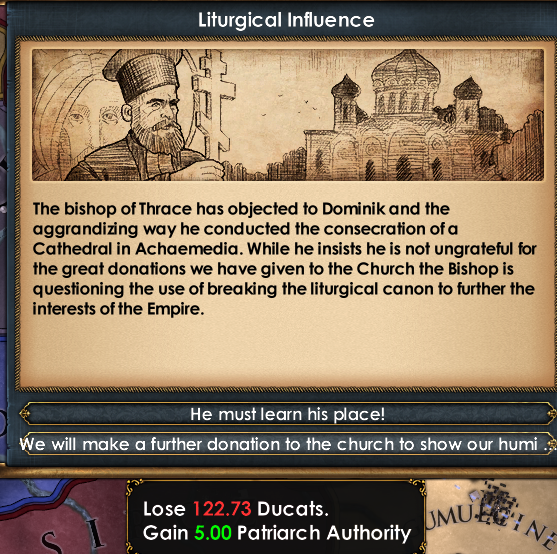Major Powers of the World
We’ll come to a more detailed look at the Achaemenid Empire at the turn of the century, but first, it’s important to outline the world the empire finds itself in the year of our lord 1400 AD. Not included in this list are the powers in India and China. We’ll talk about them when they come to be pertinent to the story.
The Muslim States
From their inception in the deserts of Arabia, the Muslims had spread across three continents, dominating Africa north of the Sahara, penetrating deep into Asia before clashes with the Indian Rajas stymied their progress and breaking into Europe from both East and West. In less than 600 years, they had established some of the most powerful realms yet but they were riven by internal schisms similar to Christianity that set sultan against sultan and only grew deeper as the Sunnis and Shi’ites continued their wars.
The Caliphate of Castille - Sunni
From its humble origins on the Valencian coast in the 8th century, Castille would grow to become the single largest power in Western Europe until the formation of the Holy Roman Empire in the 13th century. Unlike Islam in other regions, most of its population were native Romans who sought protection from Germanic invaders in the long dark ages after the fall of the Roman Empire and not Arab or Persian migrants bringing their faith with them. They would expand steadily over the next few centuries, eventually bringing the Word of the Quran beyond the Pyrenees and conquering Aquitaine and much of central France. Their domination northwards could not last as the HRE, Valois and Arles pushed them back or broke their power in dozens of wars. Now Aquitaine is a separate Muslim state but pays respect to the spiritual leadership of Castille.
The Sultanate took on a new spiritual dimension in the 11th century as the ruler Timotheos Flavian Bin Severus Flavius became the first Caliph of Hispania claiming he was given visions by Allah to unify the European Ummah in their holy cause. Now ruled by the 7th Caliph Epiphanius Flavian, they are still mighty, rich and eager to spread their faith in the lands of Europe and beyond. Many Iberian Christians had abandoned Castille over the centuries, congregating in the Christian states of Portugal and Baetica in the South, creating a rare heterogeneity within the Caliphate.
The Ottoman Empire - Sunni
A latecomer to regional politics, the Ottoman Empire was founded by Osman and his son, Ertugrul in the wake of the breaking of Byzanstani power in Anatolia in the 11th and 12th centuries. Initially serving as swords for hires alongside a dozen other Turkish tribes who migrated to the Anatolian Plateau. They would overthrow their Nizari Shia rulers in Rum and come to control most of the peninsular except for the Meander Valley and Bithynia where small crusader states stood against the growing threat.
By 1400 AD, they had expanded their power massively, even eliminating the last vestiges of Achaemenid power in Anatolia and seem to be preparing to cross the Bosphorus in their jihad to destroy Christianity. The lands they rule are populated by Byzantines, Armeno-Cumans and Cappadocians with the Turkish horsemen forming a thin layer of elites keeping the natives subdued. Beyond the war with Christianity, they also have work to do converting the local populations away from the heretical Nizari Shia faith that many professed to during the heyday of Rum just a century ago. Always on guard against fifth-column actors and religious revolts, the Ottoman regime, led by Padishah Iollas Osmanaglu (his name a fig to the Byzantine peoples) have to be careful that as they travel abroad for conquest, they don’t leave themselves exposed to danger behind them.
The Holy State of Jerusalem - Shia
Led by the Ayatollah Kresimir Radomir who can trace his genealogy back to the first Imam of the Nizari, Tigran Vishparid and from there, the Hashimids of Egypt and even further back to the Prophet, the Holy State of Jerusalem sits at the nexus of vast wealth and religious fervour. From their initial base in Anatolia, the Nizari Shias have grown to capture the 3rd holiest site in Islam and control all of Egypt. They seek to build a religious state where faith is paramount and work to expand their influence in the region and hopefully capture Medina and Mecca from the wayward Sunnis of Arabia.
From a Christian island in a sea of Islam to a bulwark of Shia Islam in an ocean of Sunnis, the power of Jerusalem has always offered its rulers a high degree of power thanks to its fertile lands, strategic location and large population. The local Egyptians and Jerusalemians have long accepted the Nizari creed and identify themselves as one people against the Arabs and Persian states that surround them.
To the North, they have a fellow Shia kingdom in Rum but the relationship between the two are prickly, switching from ally to enemy depending on the larger geo-strategic situation.
The Eranian Empire - Sunni
The Eranian Empire grew out of an idea of a non-aligned block during the peak of Achaemenid-Parsa hostilities in the 4th and 5th centuries as the two halves of the old empire fought for influence. Formed in the 10th century, the Eranian Empire called for the diaspora of Persians to gather under its banner for protection.
Now dominating both sides of the Caucasian mountains, the Eranian Empire is ruled by the High Imam Tahtaman Telavi and has grown rich on the trade along the Silk Road. Despite this, the people of the land have proven resistant to change, preferring to hold on to the ancient ways of Persia, priding themselves on horsemanship, hunting and poetry. This slowness to adapt to technology led to the devastating loss of the Crimean steppe as the Achaemenid Empire established a new Christian kingdom there called the Bosporan Kingdom in imitation of the ancient realm of the Spartokides. Despite the embarrassing loss, the High Imam has to maintain good relations with the Tsar as Achaemeniyya is still a major clearing house for goods coming from the Caspian and steppe to the merchants of Italy. Perhaps if a new trade route overland through Europe could be found, Tahtaman would be more willing push for hostilities against the Achaemenids.
Rev Mehran and Hungary – Mutazila
Lastly, we have the aberrant Muslim state of central Europe. The Rev Mehrans and the Achaemenids of Hungary had been devout Christians for generations. Somewhere in the 13th century, a preacher named Sinistra began developing a large flock of devotees who hearkened to his message that all creeds were a lie and that man was a rationale creature who needed to seek the truth on his own terms. He would even convince the Kings of the lands to take up his faith. We aren’t sure why the message resonated so strongly in the Hungarians, descendants of the old Dacian people but it should be noted that this preacher arrived during the period of religious fervour we call the Latin Domination that had nearly destroyed the Achaemenid Empire.
Whatever the cause, the Rev Mehran dynasty and their vassals in Hungary, an Achaemenid offshoot, have stood firm in their faith, despite the hostility of the Holy Roman Empire and the recovering Achaemenid Empire.
The Christian Powers
Christianity has always been marked by the division off East and West from its earliest days of being accepted as the religion of empires. The old Roman Empire and Achaemenids had established rival churches to tend to their own citizens but the Achaemenids always viewed themselves as the paramount authority, being the first great empire to adopt Christ. These would give rise to the vicious religious wars that dominated the medieval age from the Wars for God to spread the faith in the 6th century to the Achaemenid Crusade/Great Catholic Betrayal of 1203. Tensions have eased a little since then but not by much.
The Holy Roman Empire - Catholic
Formed in the 13th century by Kaiser Gerolt I who unified all of Germania, Italy and most of the Balkans under his charismatic banner, the HRE is both the champion of Christianity, specifically Catholicism, and its greatest impediment to expansion. Never unified, the nature of the vassal contracts agreed during the time of Gerolt I meant that its member lords enjoyed a great degree of freedom to act as they wished, as long as they recognised the Kaiser as leader of Christendom and provided manpower in service of the faith.
It had been founded in imitation of the old Roman Empire that collapsed in the 6th century and had never been adequately replaced by the pretender empire that called itself the Roman Empire that lasted from the 8th century to the 13th before Gerolt tore it all down to erect his shining new entity.
In the 14th century, the Italian states seek to follow the example of the East and break away to focus on their own priorities – trade and expansion. The sitting Kaiser, Gerolt III van Gaveren is the great-grandchild of Gerolt I and still rules from Rome but sees his influence slowly ebb away as German Kings in Alemania and Asciburgia contest the election for the next Kaiser.
Axuchos – Khodan Orthodox
The state of Axuchos or Valois as it used to be known was the tinderbox that ignited the Catholic-Orthodox wars of the 11th and 12th centuries. Orthodox expansion into France gave rise to resentment and calls of heresy against the Achaemenids and nearly saw their empire destroyed and replaced a Latin Empire. In the intervening period, the rulers of Valois would find a compromise with the Catholics of the West and agree to cede certain points of doctrine – in effect entering communion with the Papacy, and abandoning key Khodan tenets. This allowed the state to survive and in 1400, it and its vassals dominate northern France and seek to push the Muslims back across the Pyrenees and off rightful French clay. The Kingdom is ruled by King Khodadad Axurchos, after the previous Kozman dynasty died out. The Axurchos are foreigners, hailing from the Orthodox East but are trying their best to adapt to French culture to keep their nobles docile and compliant.
Archduchy of Austria - Catholic
Austria is a rising power in Germany and Central Europe. Only recently formed, they seek to contest the elections for the HRE and capitalise on the path of expansion eastwards into Orthodox and Muslim lands. Ruled by Tvrtko Lopac, the Austrians are another of a range of Germanic powers that threaten to make the early-modern era a German one.







































